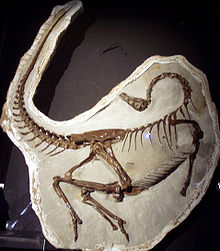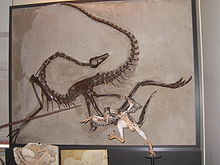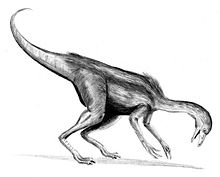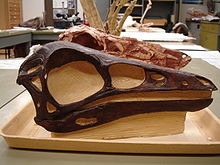- Ornithomimus
-
Ornithomimus
Temporal range: Late Cretaceous, 75–65.5 Ma
O. edmontonicus specimen, Royal Tyrrell Museum Scientific classification 
Kingdom: Animalia Phylum: Chordata Class: Reptilia Superorder: Dinosauria Order: Saurischia Suborder: Theropoda Family: †Ornithomimidae Subfamily: †Ornithomiminae Genus: †Ornithomimus
Marsh, 1890Type species Ornithomimus velox
Marsh, 1890Species O. antiquus?
Leidy, 1865 [originally Coelosaurus]
O. velox
Marsh, 1890
O. edmontonicus
Sternberg, 1933Synonyms Dromiceiomimus Russell, 1972
Ornithomimus (
 /ˌɔrnɨθɵˈmaɪməs/; "bird mimic") is a genus of ornithomimid theropod dinosaur from the Late Cretaceous Period of what is now North America.
/ˌɔrnɨθɵˈmaɪməs/; "bird mimic") is a genus of ornithomimid theropod dinosaur from the Late Cretaceous Period of what is now North America.In 1890 Ornithomimus velox was named by Othniel Charles Marsh on the basis of a foot and partial hand from the Maastrichtian Denver Formation. Another seventeen species have been named since. Most of these have subsequently been assigned to new genera or shown to be not directly related to Ornithomimus. The best material of species still considered part of the genus has been found in Canada, representing the earlier Edmontonian-age Ornithomimus edmontonicus Sternberg 1933, known from several skeletons. However, on some of these the new genus Dromiceiomimus including Dromiceiomimus brevitertius (Parks 1926) has been based, causing taxonomic problems of priority and identity that are still unresolved.
Ornithomimus was a relatively small swift bipedal animal, equipped with a small toothless beaked head, that may indicate an omnivorous diet.
Contents
Description
Like other ornithomimids, Ornithomimus is characterized by a foot with three weight-bearing toes, long slender arms and a long neck with a birdlike, elongated, toothless, beaked skull. It was bipedal and superficially resembled an ostrich, except for its long tail. It would have been a swift runner. It had very long limbs, hollow bones, and a large brain and eyes. The brains of ornithomimids were large for dinosaurs, but this may not necessarily be a sign of greater intelligence; some paleontologists think that the enlarged portions of the brain were dedicated to kinesthetic coordination.[1] Their hands are remarkably sloth-like in appearance, which led Henry Fairfield Osborn to suggest that they were used to hook branches during feeding.
Ornithomimus differs from other ornithomimids, such as Struthiomimus, in having a short back, long slender forearms, very slender, straight hand and foot claws and in having metacarpals and fingers of similar lengths.[2]
The three Ornithomimus species today seen as possibly valid, differ rather in size. In 2010 Gregory S. Paul estimated the length of O. edmontonicus at 3.8 metres, its weight at 170 kilograms (370 lb). One of its specimens, CMN 12228, preserves a femur (thigh bone) 46.8 centimetres (18.4 in) long. O. sedens was by Paul estimated at 4.8 metres and 350 kilograms (770 lb).[3] O. velox, the type species of Ornithomimus, is based on material of a much smaller animal. Whereas the holotype of O. edmontonicus, CMN 8632, preserves a second metacarpal eighty-four millimetres long, the same element with O. velox measures only fifty-three millimetres.
Classification and species
First species named
The history of Ornithomimus classification, and the classification of ornithomimids in general, has been complicated. The type species, Ornithomimus velox, was first named by O.C. Marsh in 1890, based on syntypes YPM 542 and YPM 548, a partial hindlimb and forelimb found on 30 June 1889 by George Lyman Cannon in the Denver Formation of Colorado. The generic name means "bird mimic", derived from Greek ὄρνις, ornis, "bird", and μῖμος, mimos, "mimic", in reference to the bird-like foot. The specific name means "swift" in Latin.[4] Simultaneously, Marsh named two other species: Ornithomimus tenuis, based on specimen USNM 5814, and Ornithomimus grandis. Both consist of fragmentary fossils found by John Bell Hatcher in Montana of which it is today understood they represent tyrannosauroid material. At first Marsh assumed Ornithomimus was a ornithopod but this changed when Hatcher found specimen USNM 4736, a partial ornithomimid skeleton, in Wyoming, which Marsh named Ornithomimus sedens in 1892. On that occasion also Ornithomimus minutus was created based on specimen YPM 1049, a metatarsus,[5] since recognized as belonging to the Alvarezsauridae.[6]
A sixth species, Ornithomimus altus, was named in 1902 by Lawrence Lambe, based on specimen CMN 930, hindlimbs found in 1901 in Alberta,[7] but this was in 1916 renamed to a separate genus, Struthiomimus, by Henry Fairfield Osborn.[8] In 1920 Charles Whitney Gilmore named Ornithomimus affinis for Dryosaurus grandis Lull 1911,[9] based on indeterminate material. In 1930 Loris Russell renamed Struthiomimus brevetertius Parks 1926 and Struthiomimus samueli Parks 1928 into Ornithomimus brevitertius and Ornithomimus samueli.[10] The same year Oliver Perry Hay renamed Aublysodon mirandus Leidy 1868 into Ornithomimus mirandus,[11] today seen as a nomen dubium. In 1933 William Arthur Parks created a Ornithomimus elegans,[12] today seen as either belonging to Chirostenotes or Elmisaurus. That same year, Gilmore named Ornithomimus asiaticus for material found in Inner Mongolia.[13]
Also in 1933, Charles Mortram Sternberg named the species Ornithomimus edmontonicus for a nearly complete skeleton from the Horseshoe Canyon Formation of Alberta, specimen CMN 8632.[14]
Reclassification by Dale Russell
At first it had been common to name each newly discovered ornithomimid as a species of Ornithomimus. In the sixties, this tendency was still strong as is shown by the fact that Oskar Kuhn renamed Megalosaurus lonzeensis Dollo 1903 from Belgium into Ornithomimus lonzeensis (today understood to be a abelisauroid claw),[15] and Dale Rusell in 1967 renamed Struthiomimus currellii Parks 1933 and Struthiomimus ingens Parks 1933 into Ornithomimus currellii and Ornithomimus ingens.[16] At the same time it was usual that workers referred to the entire ornithomimid material as simply "Struthiomimus".[17] To solve this confusion by scientifically testing the separation between Ornithomimus and Struthiomimus, in 1972 Dale Russell published a morphometric study showing that statistical differences in some proportions could be used to distinguish the two. He concluded that Struthiomimus and Ornithomimus were valid genera. In the latter Russell recognised two species: the type species Ornithomimus velox and Ornithomimus edmontonicus even though he had trouble reliably distinguishing it from O. velox. Struthiomimus currellii he considered a younger synomym of Ornithomimus edmontonicus. However, Russell also interpreted the data as indicating that many specimens could not be referred to either Ornithomimus or Struthiomimus. Therefore he created two new genera. The first was Archaeornithomimus to which Ornithomimus asiaticus and Ornithomimus affinis were assigned, becoming an Archaeornithomimus asiaticus and an Archaeornithomimus affinis. The second genus was Dromiceiomimus, meaning "Emu mimic" from the old generic name for the emu, Dromiceius. Russell assigned several former Ornithomimus species named during the 20th century, including O. brevitertius and O. ingens, to the new genus as Dromiceimimus brevitertius. He renamed Ornithomimus samueli into a second Dromiceiomimus species: Dromiceiomimus samueli.[18]
Final species named
The first Ornithomimus remains ever found may be two tibiae from the Navesink Formation of New Jersey belonging to divers material named Coelosaurus antiquus ("antique hollow lizard") by Joseph Leidy in 1865. The tibiae were first attributed to Ornithomimus in 1979 by Donald Baird and John R. Horner as Ornithomimus antiquus.[19] Normally, this would have made Ornithomimus a junior synonym of Coelosaurus, but Baird and Horner discovered that the name "Coelosaurus" was preoccupied by a dubious taxon based on a single vertebra, named Coelosaurus by an anonymous author now known to be Richard Owen in 1854.[20] Baird referred several other specimens from New Jersey and Maryland to O. antiquus. Beginning in 1997, Robert Sullivan regarded O. velox and O. edmontonicus as junior synonyms of O. antiquus. Like Russell, he considered the former two species indistinguishable from each other, and noted that they both shared distinctive features with O. antiquus.[21] However, David Weishampel (2004) considered "C." antiquus to be indeterminate among ornithomimosaurs, and therefore a nomen dubium.[20]
In 1988 Gregory S. Paul renamed Gallimimus bullatus into Ornithomimus bullatus.[22] This has found no acceptance among other workers and presently the name is not used by Paul himself.
Present interpretations
Even after Russell's study, various researchers have found reasons to lump some or all of these species back into Ornithomimus in various combinations. In 2004, Peter Makovicky, Yoshitsugu Kobayashi and Phil Currie studied Russell's 1972 proportional statistics to re-analyze ornithomimid relationships in light of new specimens. They concluded that there was no justification to separate Dromiceiomimus from Ornithomimus, noting that Dromiceiomimus must therefore be considered a synonym of O. edmontonicus.[23] However, they did not include the type species of Ornithomimus, O. velox, in this analysis. The same team further supported the synonymy between Dromiceiomimus and O. edmontonicus in a 2006 lecture at the Society of Vertebrate Paleontology annual meeting,[24] and their opinion was further supported in a paper by Nicholas Longrich in 2008.[25] Makovicky's team also considered Dromiceiomimus samueli to be a junior synonym of O. edmontonicus, though Longrich suggested it may belong to a distinct species also represented by Ornithomimus remains from the Dinosaur Park Formation which have yet to be described.[25]
 O. edmontonicus (formerly Dromiceiomimus) skeleton, with Sinornithosaurus model, at the Canadian Museum of Nature
O. edmontonicus (formerly Dromiceiomimus) skeleton, with Sinornithosaurus model, at the Canadian Museum of Nature
Apart from O. edmontonicus dating to the early Maastrichtian, two other species are presently considered to be possibly valid, both from the late Maastrichtian. O. sedens was named by Marsh in 1891 from partial remains found in the Lance Formation of Wyoming, only one year after the description of O. velox. Dale Russell, in his 1972 revision of ornithomimids, could not determine which genus it actually belonged to, though he speculated that it may be intermediate between Struthiomimus and Dromiceiomimus. In 1985 he considered it a species of Ornithomimus.[26] It has since been referred to mainly as Struthiomimus sedens, based on complete specimens from Montana (as well as some fragments from Alberta and Saskatchewan), though these yet have to be described and compared to the O. sedens holotype.[25]
The other is the original type species: O. velox, at first known from very limited remains. Additional specimens referred to O. velox have been described from the Denver Formation and from the Ferris Formation of Wyoming.[27] One specimen attributed to O. velox from the Kaiparowitz Formation of Utah, was described in 1985.[26] Re-evaluation of this specimen by Lindsay Zanno and colleagues in 2010, however, cast doubt on its assignment to O. velox, and possibly even to Ornithomimus.[28]
Phylogeny
In 1890 Marsh assigned Ornithomimus to the Ornithomimidae, a classification that is still common. Modern cladistic studies indicate a derived position in the ornithomimids; these however have only included O. edmontonicus in their analyses. The relationships between O. edmontonicus, O. velox and O. sedens have not been published.
Paleobiology
The diet of Ornithomimus is still debated. As theropods, ornithomimids might have been carnivorous but their body shape would also have been suited for a partly or largely herbivorous lifestyle. Suggested food includes insects, crustaceans, fruit, leaves, branches, eggs, and the meat of lizards and small mammals.[1]
Ornithomimus had legs that seem clearly suited for rapid locomotion, with the tibia about 20% longer than the femur. The large eye sockets suggest a keen visual sense, and also suggest the possibility that they were nocturnal.[29]
In a 2001 study conducted by Bruce Rothschild and other paleontologists, 178 foot bones referred to Ornithomimus were examined for signs of stress fracture, but none were found.[30]
References
- ^ a b "Dromiceiomimus." In: Dodson, Peter & Britt, Brooks & Carpenter, Kenneth & Forster, Catherine A. & Gillette, David D. & Norell, Mark A. & Olshevsky, George & Parrish, J. Michael & Weishampel, David B. The Age of Dinosaurs. Publications International, LTD. p. 140. ISBN 0-7853-0443-6.
- ^ Makovicky, P.J., Kobayashi, Y., and Currie, P.J. (2004). "Ornithomimosauria." In Weishampel, D.B., Dodson, P., & Osmólska, H. (eds.), The Dinosauria (second edition). University of California Press, Berkeley: 137-150.
- ^ Paul, G.S., 2010, The Princeton Field Guide to Dinosaurs, Princeton University Press p. 117
- ^ O.C. Marsh, 1890, "Description of new dinosaurian reptiles", The American Journal of Science, series 3 39: 81-86
- ^ O.C. Marsh, 1892, "Notice of new reptiles from the Laramie Formation", American Journal of Science 43: 449-453
- ^ Holtz, Thomas R. Jr. (2011) Dinosaurs: The Most Complete, Up-to-Date Encyclopedia for Dinosaur Lovers of All Ages, Winter 2010 Appendix.
- ^ Lambe, L., 1902, "New genera and species from the Belly River Series (mid-Cretaceous)", Geological Survey of Canada Contributions to Canadian Palaeontology 3(2): 25-81
- ^ H.F. Osborn, 1916, "Skeletal adaptations of Ornitholestes, Struthiomimus, Tyrannosaurus", Bulletin of the American Museum of Natural History 35(43): 733-771
- ^ Gilmore, C.W., 1920, "Osteology of the carnivorous Dinosauria in the United States National Museum with special reference to the genera Antrodemus (Allosaurus) and Ceratosaurus, United States National Museum Bulletin 110: l-154
- ^ Russell, L.S., 1930, "Upper Cretaceous dinosaur faunas of North America", Proceedings of the American Philosophical Society, 69(4): 133-159
- ^ Hay, O.P., 1930, Second Bibliography and Catalogue of the Fossil Vertebrata of North America. Carnegie Institution of Washington. 390(II): 1-1074
- ^ Parks, W.A., 1933, "New species of dinosaurs and turtles from the Upper Cretaceous formations of Alberta", University of Toronto Studies, Geological Series, 34: 1-33
- ^ Gilmore, C.W., 1933, "On the dinosaurian fauna of the Iren Dabasu Formation", Bulletin of the American Museum of Natural History, 67: 23-78
- ^ Sternberg, C.M., 1933, "A new Ornithomimus with complete abdominal cuirass", The Canadian Field-Naturalist 47(5): 79-83 *Parks, W.A., 1933, "New species of dinosaurs and turtles from the Upper Cretaceous formations of Alberta", University of Toronto Studies, Geological Series, 34: 1-33
- ^ Kuhn, O., 1965, "Saurischia (Supplementum 1)". In: Fossilium Catalogus 1. Animalia. 109: 1-94
- ^ Russell, D.A. and Chamney, T.P., 1967, "Notes on the biostratigraphy of dinosaurian and microfossil faunas in the Edmonton Formation (Cretaceous), Alberta", National Museum of Canada Natural History Papers, 35: 1-22
- ^ Norman, D., 1985, The Illustrated Encyclopedia of Dinosaurs, Crescent Books, New York, p. 48
- ^ Russell, D. (1972). "Ostrich dinosaurs from the Late Cretaceous of western Canada." Canadian Journal of Earth Sciences, 9: 375-402.
- ^ Baird D., and Horner, J., 1979, "Cretaceous dinosaurs of North Carolina", Brimleyana 2: 1-28
- ^ a b Weishampel, D.B. (2004). "Another Look at the Dinosaurs of the East Coast of North America. En (Colectivo Arqueológico-Paleontológico Salense, Ed.)." Actas de las III Jornadas sobre Dinosaurios y su Entorno. 129-168. Salas de los Infantes, Burgos, España.
- ^ Sullivan, (1997). "A juvenile Ornithomimus antiquus (Dinosauria: Theropoda: Ornithomimosauria), from the Upper Cretaceous Kirtland Formation (De-na-zin Member), San Juan Basin, New Mexico." New Mexico Geological Society Guidebook, 48th Field Conference, Mesozoic Geology and Paleontology of the Four Corners Region. 249-254.
- ^ Paul, G.S., 1988, Predatory Dinosaurs of the World. Simon & Schuster: New York. 464 pp
- ^ Makovicky, Kobayashi and Currie (2004). "Ornithomimosauria." In Weishampel, Dodson and Osmolska (eds.), The Dinosauria Second Edition. University of California Press. 861 pp.
- ^ Kobayashi, Makovicky and Currie (2006). "Ornithomimids (Theropoda: Dinosauria) from the Late Cretaceous of Alberta, Canada." Journal of Vertebrate Paleontology, 26(3): 86A.
- ^ a b c Longrich, N. (2008). "A new, large ornithomimid from the Cretaceous Dinosaur Park Formation of Alberta, Canada: Implications for the study of dissociated dinosaur remains." Palaeontology, 51(4): 983-997.
- ^ a b DeCourten and Russell, D. (1985). "A specimen of Ornithomimus velox (Theropoda, Ornithomimidae) from the terminal Cretaceous Kaiparowits Formation of southern Utah." Journal of Paleontology, 59(5): 1091-1099.
- ^ Lillegraven and Eberle (1999). "Vertebrate faunal changes through Lancian and Puercan time in southern Wyoming." Journal of Paleontology, 73(4): 691-710.
- ^ Zanno, L.E., Weirsma, J.P., Loewen, M.A., Sampson, S.D. and Getty, M.A. (2010). A preliminary report on the theropod dinosaur fauna of the late Campanian Kaiparowits Formation, Grand Staircase-Escalante National Monument, Utah." Learning from the Land Symposium: Geology and Paleontology. Washington, DC: Bureau of Land Management.
- ^ Palmer, D., ed (1999). The Marshall Illustrated Encyclopedia of Dinosaurs and Prehistoric Animals. London: Marshall Editions. p. 109. ISBN 1-84028-152-9.
- ^ Rothschild, B., Tanke, D. H., and Ford, T. L., 2001, Theropod stress fractures and tendon avulsions as a clue to activity: In: Mesozoic Vertebrate Life, edited by Tanke, D. H., and Carpenter, K., Indiana University Press, p. 331-336.
External links
- Ornithomimus in The Dinosaur Encyclopaedia at Dino Russ' Lair
Categories:- Cretaceous dinosaurs
- Dinosaurs of North America
- Fossil taxa described in 1890
- Ornithomimosaurs
Wikimedia Foundation. 2010.


